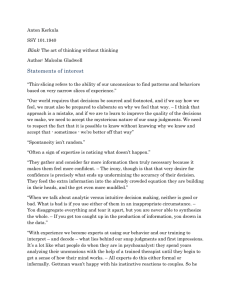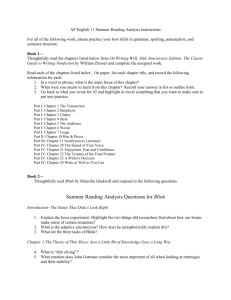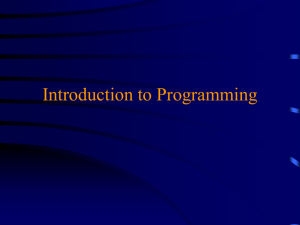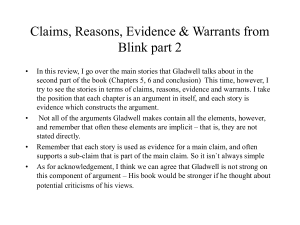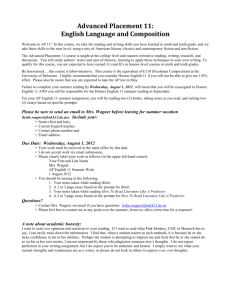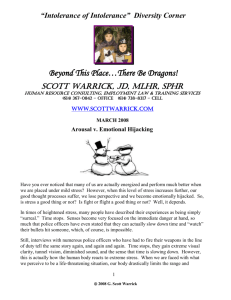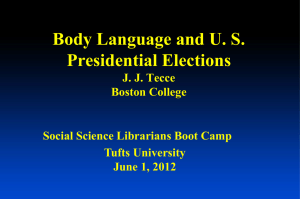blink - Research Writing
advertisement
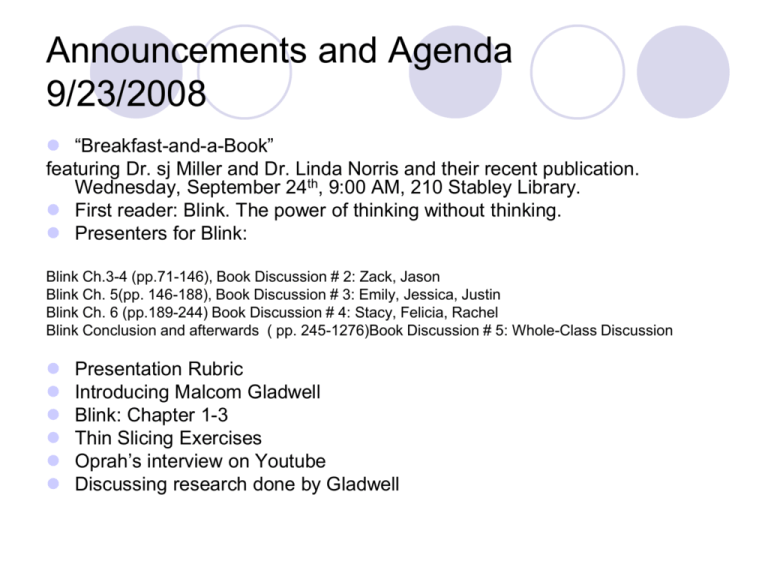
Announcements and Agenda 9/23/2008 “Breakfast-and-a-Book” featuring Dr. sj Miller and Dr. Linda Norris and their recent publication. Wednesday, September 24th, 9:00 AM, 210 Stabley Library. First reader: Blink. The power of thinking without thinking. Presenters for Blink: Blink Ch.3-4 (pp.71-146), Book Discussion # 2: Zack, Jason Blink Ch. 5(pp. 146-188), Book Discussion # 3: Emily, Jessica, Justin Blink Ch. 6 (pp.189-244) Book Discussion # 4: Stacy, Felicia, Rachel Blink Conclusion and afterwards ( pp. 245-1276)Book Discussion # 5: Whole-Class Discussion Presentation Rubric Introducing Malcom Gladwell Blink: Chapter 1-3 Thin Slicing Exercises Oprah’s interview on Youtube Discussing research done by Gladwell blink The power of thinking without thinking By Malcom Gladwell Who is Malcolm Gladwell? Born in U.K., 1963 Author and New Yorker Magazine journalist since 1996 His books: Gladwell, Malcolm (2000). The Tipping Point: How Little Things Can Make a Big Difference. Boston: Little, Brown. Gladwell, Malcolm (2005). Blink: The Power of Thinking Without Thinking. Boston: Little, Brown. Website: http://www.gladwell.com/ What is the book about?—Class discussion: Going with your intuition Thin-slicing Snap decisions Our unconsciousness Thin-slicing Our unconscious is able to find patterns in situations and behavior based on very narrow slices of experience. This is called “thin slicing” Chapter 1: The theory of thin slicing Marriage and Morse Code: John Gottman’s example (p.18-23) --thin slicing marriages: he kept track of emotional patterns -- one single important sign in this code: Contempt 32-33 Why do we thin-slice? When do we thin slice?(43-45)-- “Court sense”, “coup d’oeil” Thin slicing exercises The psychologist, Samuel Gosling, shows how 'thin-slicing' can be used to judge people's personality when he uses the dorm room observers. Visualize your bedroom right now. What does it say about you? If scrolling through someone's iPod or scanning their bookshelf can tell us more about that individual, what other kinds of 'thin-slicing' exercises could reveal aspects of their personality? Chapter 2: The locked Door: Secret Life of Snap Decisions Priming( 53-54) Speed Dating ( 61-67) Priming 1. Priming refers to when subtle triggers influence our behavior without our awareness of such changes. An example of this occurs in Spain where authorities introduced classical music on the subway and after doing so, watched vandalism and littering drastically decrease. Can you think of situations when priming occurs? 2. Should we introduce priming in schools to encourage better behavior or more diligent work patterns? What about the service industry? If an individual's behavior is being influenced unbeknownst to them, when can priming become manipulative? How is it different from the controversy a few years back when cinemas used subliminal advertising during previews to 'encourage' people to buy from the confectionary stand? Speed Dating Activity Class activity. 1. Give yourself an imaginary social role(s). You can be a lawyer in your 30s, single, living in L.A; or a police officer in your 40s from Puerto Rico. Be creative! 2. Divide up the class into two. Each group should have equal numbers of males and females (if not, we’ll need to create fictional characters) 3. In each group, women will sit while men rotate from woman to woman introducing themselves and having a conversation. The bell will ring signaling that one minute is over. After each man completes their introductions to each woman, it will be the women’s turn to introduce themselves. 4. When each group completes the introductions, you will write down/prioritize three names on a piece of paper. Reflections on the activity and class discussion How did you evaluate the men/women in your group? Have you dated someone that was the antithesis of what you thought you found attractive? Is there even a point of asking someone, "what's your type?" Assignments Read Blink, Chapter 3-4 Agenda 9/25/2008 Great job in thin-slicing activities last class! Group Presentation Information (Blog writing) Trust-building activities. How to work well in groups. Jason and Zack presents… Feedback for presenters Generating Topics. Finding out what is important to you! Trust lean In pairs of similar size, one becomes a Faller and one the Catcher. Teach methods for spotting, falling and catching. Start small and build to bigger falls, then swap. Debrief - what made you feel more or less trusting? Adapted from: http://wilderdom.com/games/TrustActivities.html Slice ‘N dice A dramatic trust activity for a large group. Group forms a gauntlet, arms out in front. As a person walks down the gauntlet, people raise their arms. Build up to people down running the gauntlet through a sea of chopping arms! Assignments Read Blink Ch. 5 (pp. 146-188), Generate topic(s) for your research paper. Are you procrastinating, thinking? Work on your “Shitty First Drafts” AN (UN)ANNOUNCED QUIZ NEXT WEEK! Agenda 9/30/2008 Remember to vote! No matter who wins, the election will make history.The deadline to register in Pennsylvania for voting in the Nov. presidential election is Oct. 6th. Trust-building activities. How to work well in groups. Presentation on Blink: Emily, Jessica and Justin. Feedback for presenters Working on your “shitty first drafts”: Research in progress --Generating compelling research topics --Reporting versus arguing --Generating research questions Trust building activity #2 DIRECTIONS Form two lines, facing one another, creating a corridor or gauntlet. Put out your arms straight in front. Arms should intersect, overlapping by about a hand with arms of people opposite. The first person peels off and walks down the corridor. In order to let the person pass, people raise and then lower their arms, creating a Mexican wave effect - a ripple through which a person is walking. The person then joins in again at the end of the line. Next person, peels off, walks, down, and so on. As the group gets more confident, invite people to walk fast, run, and then sprint down the gauntlet (take great care to raise your arms in time!). At some point, or for the finale, have people chop their arms up and down, only pausing to allow the gauntlet-runner through. It works! http://wilderdom.com/games/descriptions/SliceNDice.html Typical Research Process Typical Research Process How can you make your topic manageable? Reflect on your topic: -- How appropriate is this topic to the writing situation? --How interested are you in your topic? Why do you think your topic is important? Think about social, cultural, political or economic significance of your topic to your larger community. --Who is your audience? --What sources are available regarding this topic? Journals? Books? Online resources? --What types of resources/data does your audience value? Numbers and statistics? Stories? Interviews? Case studies? Ethnographies? Developing your research questions One of the most effective ways to get started on your research is to think of your topic in terms of a question. Try to avoid yes/no questions. Try to come up with a series of questions that start with: who, what, where, how, when. e.g., How do young kinds learn reading and writing? What is the controversy around the idea of thin-slicing? Why are organic products more expensive than nonorganic products? See Good Reasons 248 about strategies for research. Reporting versus arguing REPORTING ARGUING Summarizing Interpreting Paraphrasing Analyzing Quoting Quoting AND Concluding Describing Claiming Telling Persuading Examples:???? Examples:???? Assignments Read Blink--Chapter 6 Read Good Reasons--Chapter 6 Quiz—Chapters 1-6 Agenda/Announcements for 10/2/2008 Melissa from VOTEIUP Change in the syllabus/due dates: October 7: Library workshop. Book review # 1 due. Blog Post: A reflective paragraph on your research. October 9: Covering 1(Brandi, Andrea, Brandon) and Covering 2 (Brenna, Alex, Beth) Quiz on Blink Presentation on Blink Chapter 6 Remember that we are meeting in library next Tuesday (Room # 210). Analyzing Visual Text Table Talks on Blink “Table Talk”--an evening of discussion loosely modeled on the "speed dating" phenomenon. Throughout the 2-hour event, students will be encouraged to participate in three 20-minute discussions of their choice. The “Table Talk” event will be held on Thursday evening, November 13, 6:00-8:00 p.m. in the HUB. It will begin in the Ohio Room, and then break-out sessions will be held at various tables that have been designed to stimulate dialogue on topics relevant to the book. Last year, almost 300 students and 65 faculty and student presenters participated in this event, making it a huge success! Need extra credit? Send me an email to attend this event. Research Methods Qualitative: E.g., Interviews, ethnographies, surveys, case studies, visual analysis, narratives, etc. Quantitative: E.g., Numbers, charts, statistical information, surveys etc. Visual Analysis Visuals around us make various claims and arguments. Visual arguments could be more powerful than written as they invite us to make our own claims. The goal: to present a clear understanding of the visuals. Class Activity: Analyzing Visual Arguments Get into groups of 3-4 Pick one photo/ad that you would like to analyze. Discuss questions on page: Good Reasons, pg. 104-106 Assignments Read Chapter 7 Read Blink Conclusion Visit class blog, and answer the prompt about your research in progress. Begin doing some background research for your projects (online vs. library) Remember that we are meeting in the library next Tuesday! Have a great weekend!

